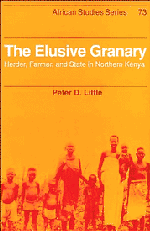Book contents
- Frontmatter
- Contents
- List of illustrations
- List of tables
- Preface
- 1 Introduction: the study of agrarian change among African herders
- 2 Society, ecology, and history
- 3 Markets and the state
- 4 Labor and agropastoral production
- 5 Income, wages, and investment
- 6 Expenditures, consumption, and the food crisis
- 7 Land conflicts and sustainability
- 8 In pursuit of the granary: development responses of community, donor, and state
- Notes
- References
- Index
- AFRICAN STUDIES SERIES
8 - In pursuit of the granary: development responses of community, donor, and state
Published online by Cambridge University Press: 04 August 2010
- Frontmatter
- Contents
- List of illustrations
- List of tables
- Preface
- 1 Introduction: the study of agrarian change among African herders
- 2 Society, ecology, and history
- 3 Markets and the state
- 4 Labor and agropastoral production
- 5 Income, wages, and investment
- 6 Expenditures, consumption, and the food crisis
- 7 Land conflicts and sustainability
- 8 In pursuit of the granary: development responses of community, donor, and state
- Notes
- References
- Index
- AFRICAN STUDIES SERIES
Summary
The term “crisis” can be used to describe II Chamus since the initiation of largescale relief programs in the 1920s. According to certain administrators, the area had already reached an economic and ecological end point by the 1930s (Maher 1937). Despite recognition of its problems, few development efforts were launched there before the late 1970s. Those that were implemented, like the Perkerra Scheme, provided few benefits for the majority of the population. Rather than re-creating the irrigated “granary” that had existed previously, the Perkerra impoverished the area and increased its dependence on food imports. Thus, while considerable research had been conducted to identify potential development programs (Brown 1963; Maher 1937; CPK 1932–1937; Food and Agriculture Organization 1967), virtually no appropriate development efforts were initiated.
This chapter looks at development activities in II Chamus, examining the policies, programs, and ideologies that have informed them. The emphasis is on the period from 1980 to 1986, but attention is given to earlier eras as well. Lowland Baringo experienced a massive increase in the volume of development funds in the 1980s, as the area emerged as an integral component of a national arid and semiarid lands (ASAL) development program (Institute for Development Studies 1979; Kenya 1984). The chapter suggests that state and donor programs have been preoccupied with two priorities: investment in irrigation (the “granary” pursuit) and improved conservation and land management. Both have strong precedents in the colonial period. Several assumptions about the local ecology and economy, often discrepant with the realities, are made to justify development programs in II Chamus. The most important assumptions concern labor availability, homestead production and investment strategies, and the causes of range degradation.
- Type
- Chapter
- Information
- The Elusive GranaryHerder, Farmer, and State in Northern Kenya, pp. 163 - 180Publisher: Cambridge University PressPrint publication year: 1992



